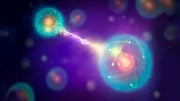
How Supercomputers Helped Link Quantum Entanglement to Cold Coffee
Theoretical physicists from Trinity have found a deep link between one of the most striking features of quantum mechanics – quantum entanglement – and thermalization, which is the process in which something comes into thermal equilibrium with its surroundings.
Their results were published on January 31, 2020, in the prestigious journal Physical Review Letters.
We are all familiar with thermalization – just think how your coffee reaches room temperature over time. Quantum entanglement on the other hand is a different story.
Yet work performed by Marlon Brenes, Ph.D. Candidate, and Professor John Goold from Trinity, in collaboration with Silvia Pappalardi and Professor Alessandro Silva at SISSA in Italy, shows how the two are inextricably linked.
Explaining the importance of the discovery, Professor Goold, leader of Trinity’s QuSys group, explains:
“Quantum entanglement is a counterintuitive feature of quantum mechanics, which allows particles that have interacted with each other at some point in time to become correlated in a way which is not possible classically. Measurements on one particle affect the outcomes of measurements of the other— even if they are light years apart. Einstein called this effect ‘spooky action at a distance’.”
“It turns out that entanglement is not just spooky but actually ubiquitous and in fact what is even more amazing is that we live in an age where technology is starting to exploit this feature to perform feats which were thought to be impossible just a number of years go. These quantum technologies are being developed rapidly in the private sector with companies such as Google and IBM leading the race.”
But what has all this got to do with cold coffee?
Professor Goold elaborates:
“When you prepare a cup of coffee and leave it for a while it will cool down until it reaches the temperature of its surroundings. This is thermalization. In physics we say that the process is irreversible – as we know, our once-warm coffee won’t cool down and then magically warm back up. How irreversibility and thermal behavior emerges in physical systems is something which fascinates me as a scientist as it applies on scales as small as atoms, to cups of coffee, and even to the evolution of the universe itself. In physics, statistical mechanics is the theory which aims at understanding this process from a microscopic perspective. For quantum systems the emergence of thermalization is notoriously tricky and is a central focus of this current research.”
So what’s all this got to do with entanglement and what do your results say?
Professor Goold says:
“In statistical mechanics there are various different ways, known as ensembles, in which you can describe how a system thermalizes, all of which are believed to be equivalent when you have a large system (roughly on scales of 10^23 atoms). However, what we show in our work is that not only is entanglement present in the process, but its structure is very different depending on which way you choose to describe your system. So, it gives us a way to test foundational questions in statistical mechanics. The idea is general and can be applied to a range of systems as small as a few atoms and as large as black holes.”
Marlon Brenes, Ph.D. candidate at Trinity and first author of the paper, used super-computers to simulate quantum systems to test the idea.
Brenes, a numerical specialist, said:
“The numerical simulations for this project that I performed are at the limit of what can currently be done at the level of high-performance computing. To run the code I used the national facility, ICHEC, and the new Kay machine there. So, as well as being a nice fundamental result the work helped us really push the boundaries of this type of computational approach and establish that our codes and the national architecture are performing at the cutting edge.”
Reference: “Multipartite Entanglement Structure in the Eigenstate Thermalization Hypothesis” by Marlon Brenes, Silvia Pappalardi, John Goold and Alessandro Silva, 31 January 2020, Physical Review Letters.
DOI: 10.1103/PhysRevLett.124.040605
Professor Goold’s research is supported by an SFI-Royal Society University Research Fellowship and a European Council Starting Grant.








As you may know, Quantum Entanglement is perhaps the strangest phenomenon in physics. The name is scary enough, but it means that some small particles may communicate with each other instantly and over vast distances. How can that happen without violating the maximum speed in the universe, the speed of light?
The two ways physicists have used to answer this, that the particles contain hidden variables of unknown natures and that the universe is completely deterministic with all results predefined, have been shown to be not correct. Besides cold coffee, now what?
Perhaps concepts in String Theory can help. There are 11 possible dimensions in String Theory and maybe one of them leads a way around, what Einstein called, “spooky action at a distance”. Specifics can be found in my YouTube at https://www.youtube.com/watch?v=4ZqK0j5U8Ro&t=3s
If the universe is not deterministic, how do the non-deterministic particles and forces decide which way to move if it’s not down to cause and effect
‘Steady State of The Infinite’
Infinite space-infinite universes-no beginning-no end
String walks into bar.
Bartender: “Hey, we don’t serve strings in here”.
String crawls out, frays his ends and ties himself into a bow.
Walks back in.
Bartender: “Aint you that string that was just here?”
String: No, I am afraid not.
Bartender: Are you trying to get tangled with me?
I, an interested layman, read about these topics with interest, but as yet I have seen nothing to convince me that entanglement light years away, or anywhere else where we can’t go, is verifiable. I have read books by Hawkings and Carroll and found nothing but claims that entanglement is real. If one could describe *how* you verify entanglement, e.g., do this with this instrument and that with that one, that would help. Even so, light years away? That just sounds like a whopper to me.
When two quantum systems interact- say two electrons- their quantum properties “mix” and become a single quantum system- they are no longer two individual systems. Quantum systems are either there or they’re not- you don’t get to have partial quanta. So, if one aspect of this quantized system changes, the other one HAS to change too- there is no other option for it. If there was, the system wouldn’t be quantized- you’d have more or less than a whole quanta, which is not possible. As for measuring entanglement, you can create entangled pairs of particles and send them down two different paths and then make measurements on them at the end of each path. It’s only when you compare the results from both measuring devices (using classical communication channels) that you discover the behavior of the two particles are correlated. You can’t actually transmit information because you can’t verify the legitimacy of the information without comparing both measurements of the system and that has to be done via classical means. So far, researchers have been able to verify entanglement over very long distances- to a satellite in space and back, for instance- and have found the time differential to be at least 10,000 times faster than the speed of light (the clocks used in the experiments limit the precision of the measurement).
I’m sure the work done was good science, not questioning that, but the summary presented here told me absolutely nothing of how entanglement explains thermalization.